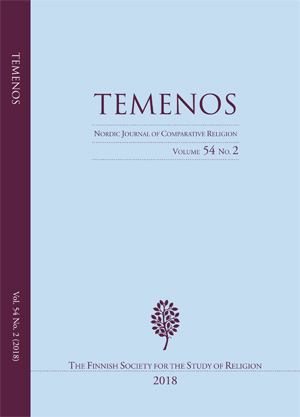From Bones to Sacred Artefact
The Late Medieval Skull Relic of Turku Cathedral, Finland
DOI:
https://doi.org/10.33356/temenos.66687Abstract
The cult of saints and the subsequent interest in relics constituted one of the essential characteristics of medieval Western Christianity. In particular, relics and reliquaries are prime examples of the importance of materiality in devotion. In the present article we analyse one of the medieval skull relics of Turku Cathedral and its material characteristics in detail. Previous examinations undertaken in the 1920s and 1940s produced two theories of its origins and identification. By analysing the bone material and the narrative depiction of martyrdom embroidered on the silk wrapping, State Archaeologist Juhani Rinne connected the relic to St Henry, the patron saint of Finland and the cathedral, while State Archaeologist Carl Axel Nordman identified it as belonging to St Eric, the patron saint of the Kingdom of Sweden. By re-examining the central element of the skull relic, the bones, with osteological analysis and radiocarbon dating, we show both theories to be highly problematic. Our analysis reveals the complex material features of the skull relic and the medieval cult of relics.
Downloads
Published
How to Cite
Issue
Section
License
Copyright (c) 2018 Temenos - Nordic Journal of Comparative Religion

This work is licensed under a Creative Commons Attribution-NonCommercial-NoDerivatives 3.0 Unported License.
Author's Guarantee
- The Author acknowledges that the Work will be publicly accessible on the Internet and that such access will be free of charge for the readers.
- The Author guarantees that the Work is her/his original work that has not been published before and cannot be construed as copying or plagiarism. Furthermore, the Author confirms that the Work contains no statement that is unlawful, defamatory or abusive or in any way infringes the rights of others.
- The Author confirms that she/he has secured all written permissions needed for the reproduction in the Publication of any material created by a third party.
User Rights
Under the CC BY 4.0 license, the Author/s and users are free to:
- Share — copy and redistribute the material in any medium or format,
- Adapt — remix, transform, and build upon the material for any purpose, even commercially,
- However, the Work must be attributed to the original Author and source of publication.
The license of the published metadata is Creative Commons CCO 1.0 Universal (CC0 1.0)
Author Rights
The Authors maintain the right to:
- copyright, and other proprietary rights relating to the Work,
- the right to use the substance of the Work in future own works,
- the right to self-archiving/parallel publishing (publisher's PDF allowed).
Rights of Publisher
- The Publisher reserves the right to make such editorial changes as may be necessary to make the Work suitable for publication in the publication, e.g. style of punctuation, spelling, headings and the like.
- The Publisher will publish the Work if the editorial process is successfully completed and reserves the right not to proceed with publication for whatever reason.
- The publication entitles the author to no royalties or other fees. This agreement will be governed by the laws of Finland.






